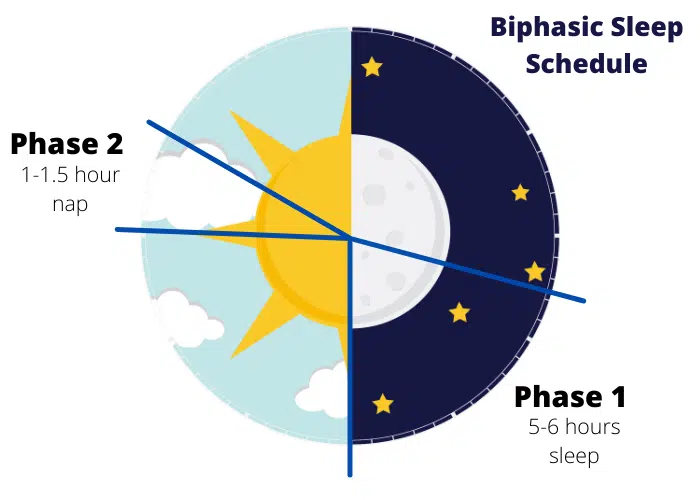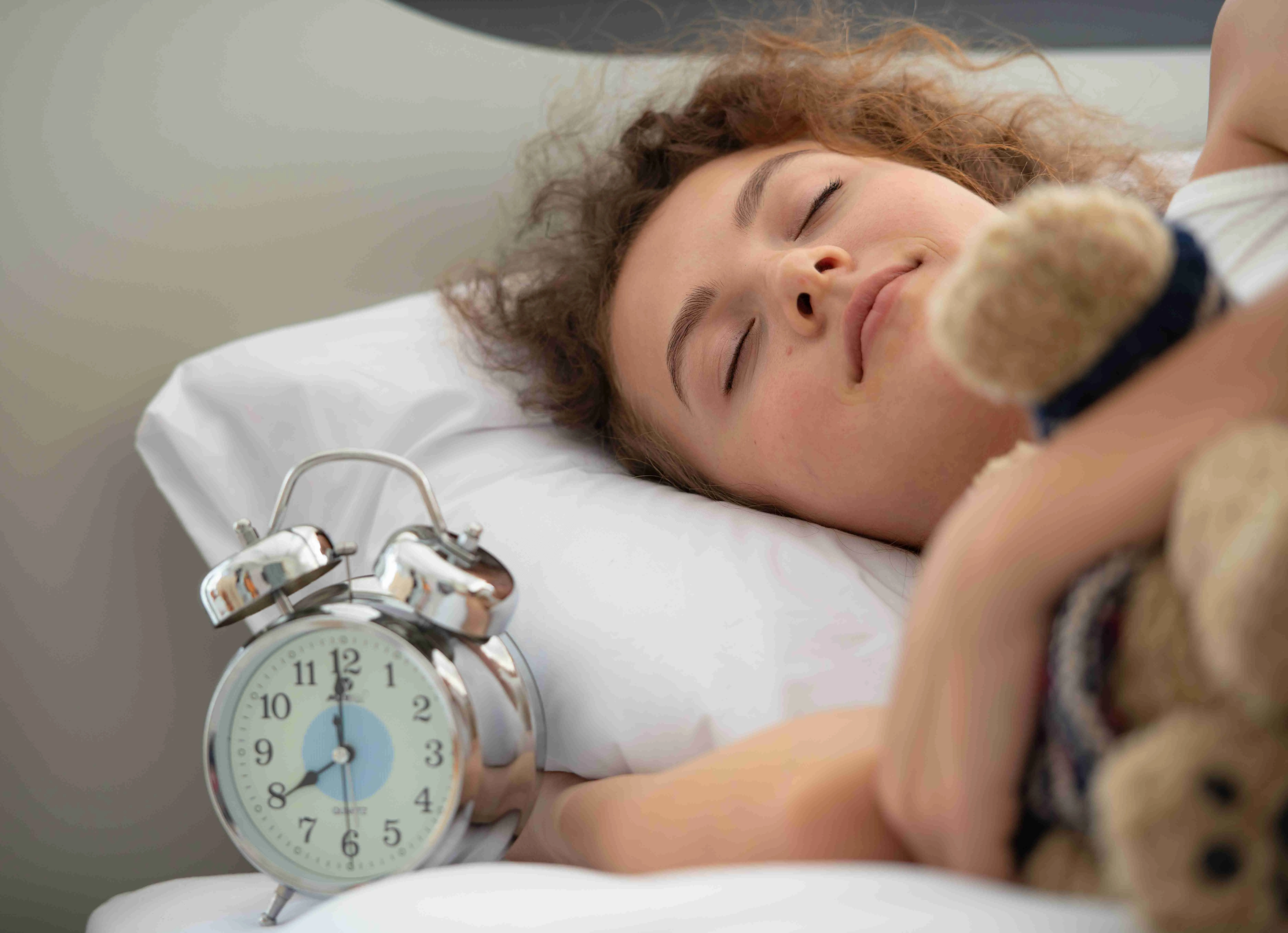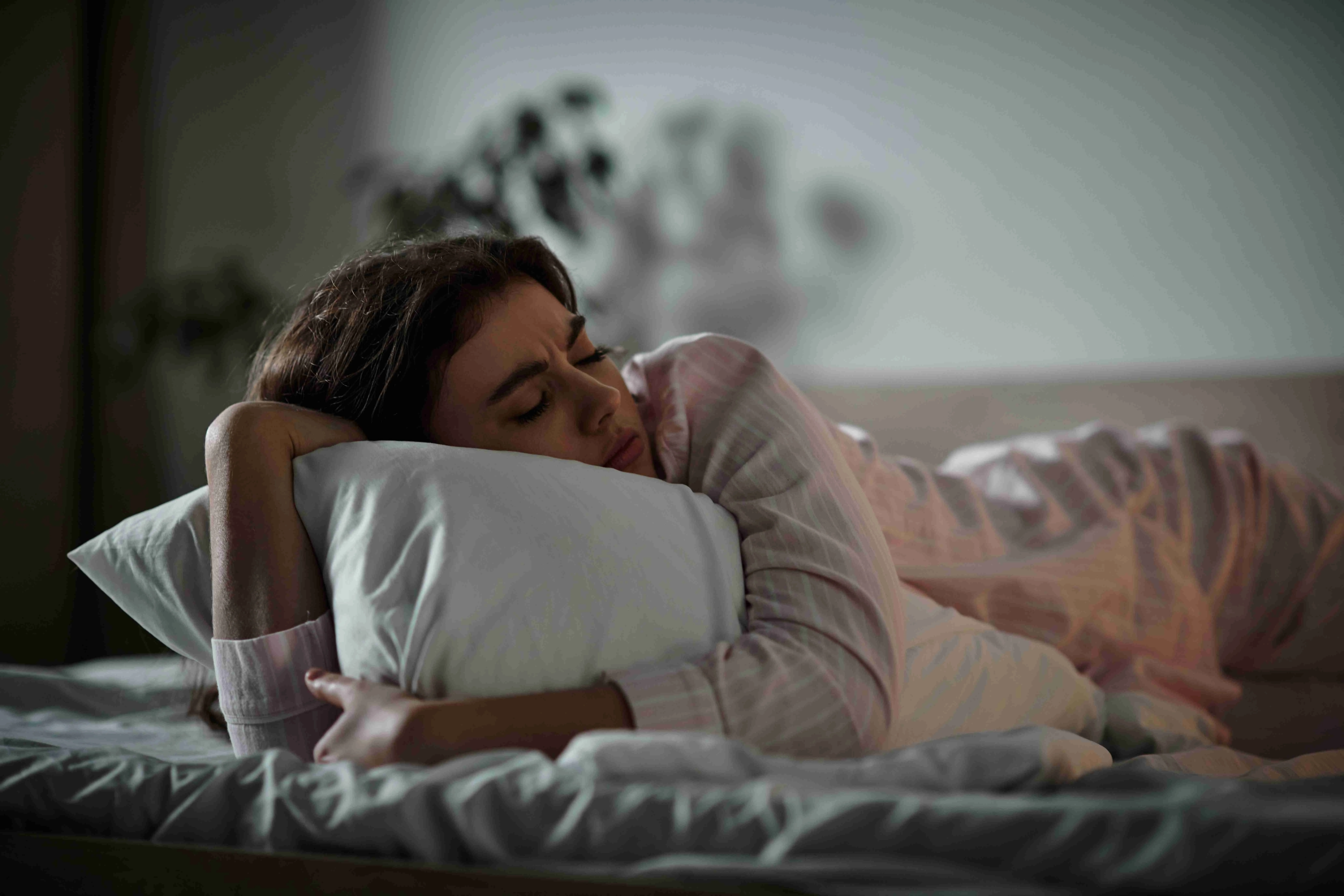In today’s fast-paced world, many people are constantly searching for ways to improve their sleep and overall productivity. One sleep pattern that has gained attention in recent years is biphasic sleep, which involves splitting sleep into two separate periods instead of sleeping in one continuous block.
In this article, we’ll explore the concept of biphasic sleep, its potential benefits, challenges, and how it compares to other sleep patterns, helping you determine whether this sleep strategy might be right for you. Understanding how sleep works can help explain biphasic sleep and its impact on overall health.
What Is Biphasic Sleep?
Biphasic sleep is a sleep pattern that involves splitting your sleep into two distinct periods during a 24-hour cycle. Instead of a single, long sleep at night, individuals who follow a biphasic schedule typically sleep for an extended period during the night (about 5-6 hours) and take a nap during the day (usually 1-2 hours).
This sleep method has been used historically in various cultures and is believed to align with the body's natural circadian rhythms.
The Science Behind Biphasic Sleep
Biphasic sleep has yielded intriguing insights into its potential effects on human physiology and cognitive function. Biphasic sleep patterns can align with our natural circadian rhythms, potentially leading to improved sleep quality and daytime alertness.
The "post-lunch dip," is a natural decrease in alertness that many people experience in the early afternoon. This dip is thought to be influenced by our circadian rhythms and may represent an ideal time for a short nap.
By incorporating a nap during this period, biphasic sleepers may be able to harness their body's natural rhythms to enhance overall sleep efficiency.
How Biphasic Sleep Differs from Monophasic and Polyphasic Sleep

To fully appreciate the unique characteristics of biphasic sleep, it's essential to understand how it compares to other sleep patterns. Let's examine the key differences between biphasic, monophasic, and polyphasic sleep:
Monophasic Sleep
Monophasic sleep is the most common sleep pattern in modern society, especially in Western cultures. It consists of a single, continuous sleep period of 7-9 hours at night. This is the typical sleep schedule that aligns with the standard 9-to-5 workday, where individuals sleep once per day, usually during the night.
Biphasic Sleep
Biphasic sleep involves dividing the sleep into two periods: a longer core sleep at night (around 5-6 hours) and a shorter nap during the day (typically 1-2 hours).
This pattern may provide flexibility for individuals with specific lifestyle needs or preferences and is thought to be more in tune with the natural ebb and flow of the body’s circadian rhythms.
Polyphasic Sleep
Polyphasic sleep refers to a sleep pattern where individuals sleep multiple times throughout the day and night, with no single sleep block longer than a few hours. This could involve several short naps (ranging from 20-90 minutes) throughout the day.
Some extreme polyphasic schedules, like the Uberman schedule, advocate for as little as 2-3 hours of total sleep across multiple short naps, but this schedule is typically not recommended due to its potential health risks.
Types of Biphasic Sleep Patterns
Biphasic sleep patterns refer to sleeping in two distinct periods during the day or night, as opposed to the more common monophasic sleep (a single block of sleep). There are several types of biphasic sleep patterns, and they can vary based on the timing and duration of the two sleep episodes. Here are the main types:
Segmented Sleep
Segmented sleep, also called "split sleep," is a biphasic sleep pattern where an individual sleeps in two separate periods, usually with a wakeful period in between.
Historically, this sleep pattern was common before the advent of artificial lighting, with people waking up in the middle of the night to engage in activities like reading, meditating, or even socializing before returning to sleep for a second block. This pattern can be ideal for those who naturally wake up in the middle of the night.
Siesta Sleep
The siesta sleep pattern is a variation of biphasic sleep that includes a long core sleep during the night, followed by a shorter nap in the afternoon, typically after lunch.
This pattern is common in regions with hot climates, such as Spain and parts of Latin America, where people rest during the afternoon heat. The nap typically lasts around 60-90 minutes and helps recharge energy levels for the rest of the day.
Benefits of Adopting a Biphasic Sleep Schedule

Adopting a biphasic sleep schedule may offer several potential benefits for your overall well-being and daily performance. Here are some of the advantages:
Increased Alertness
Adopting a biphasic sleep schedule can help maintain alertness throughout the day. By taking a nap during the day, individuals may experience a boost in cognitive function, which helps counter the natural afternoon dip in energy, leading to improved focus and mental clarity.
Enhanced Creativity
Many people find that a split sleep schedule can enhance their creativity. The ability to rest and then re-engage with tasks after a nap often leads to fresh perspectives and new ideas. Creativity is known to peak when the brain is well-rested and rejuvenated.
Improved Memory Consolidation
Sleep plays a vital role in memory consolidation, which is crucial for learning. A biphasic sleep pattern can provide ample time for this process, with the nap period supporting memory retention, making it easier to retain and recall information.
Aligns with Natural Circadian Rhythms
For some people, biphasic sleep naturally aligns with their circadian rhythms. The body may be more inclined to wake up after a few hours of sleep, and then rest again later in the day, resulting in a more natural and comfortable sleep pattern that reduces feelings of sleep deprivation.
Flexibility in Daily Schedule
A biphasic sleep schedule provides flexibility in how you structure your day. This flexibility can be especially beneficial for those with demanding jobs, school schedules, or family responsibilities, as it allows them to balance work and rest periods more effectively.
Potential Health Benefits
Biphasic sleep may offer health benefits, including reduced risk of cardiovascular problems, improved immune function, and more efficient metabolic processes. By ensuring more consistent sleep quality, this pattern may support overall physical health.
Extended Productive Hours
By splitting your sleep, you can increase your productive hours each day. Many people report that they feel more energized and capable of completing tasks after a nap, extending their workday without experiencing the typical post-lunch energy slump.
Better Time Management
With a biphasic sleep schedule, you can optimize your time by dedicating certain blocks of the day to focused work and others to rest. This can lead to better time management, as the structured sleep pattern helps prevent procrastination and supports productivity throughout the day.
Reduced Fatigue-Related Errors
Fatigue can impair decision-making and reaction times. By breaking sleep into two periods, individuals may reduce fatigue-related errors, which is especially important in high-stakes environments such as healthcare, aviation, and other critical industries.
Improved Work-Life Balance
For those with busy schedules, adopting a biphasic sleep pattern allows more flexibility to manage both work and personal life. By getting rest at multiple points during the day, individuals can stay more energized, have time for family and social activities, and reduce burnout.
Challenges of Biphasic Sleep
While biphasic sleep offers potential benefits, it's crucial to consider the possible drawbacks and challenges associated with this sleep pattern:
Difficulty in Adjusting for Insomniacs or Light Sleepers
People with insomnia or those who are light sleepers may struggle to transition to a biphasic sleep schedule. It can take longer for their bodies to adapt, and the fragmented sleep could worsen their sleep quality. The interruptions in their core sleep or nap could lead to more restlessness and difficulty in getting restful sleep.
Social Challenges
Biphasic sleep can cause social challenges, especially if your sleep and nap periods don’t align with the schedules of those around you. This can affect family interactions, social gatherings, or work meetings, potentially leading to feelings of isolation or frustration. It may require others to adjust their plans around your sleep pattern.
Misalignment with Work Schedules
For many, traditional shift work hours (9 to 5) make it difficult to adhere to a biphasic sleep schedule. If your job doesn’t allow for the flexibility of a midday nap or a split sleep schedule, it can be hard to integrate this sleep pattern without sacrificing productivity or social commitments.
Difficulty in Establishing a Consistent Routine
Adopting a biphasic sleep schedule requires strong discipline and consistency. For some people, it can be difficult to establish a consistent routine, particularly if their schedule changes frequently. External factors such as work travel, family obligations, or social events may disrupt the routine, making it harder to stick with the new pattern.
Increased Risk of Sleep Inertia
Biphasic sleep might increase the risk of sleep inertia, which is the grogginess or disorientation that some people experience after waking from a nap or interrupted sleep. If the nap isn’t timed correctly or is too long, it could leave you feeling more tired than refreshed, potentially making it harder to get back into a productive routine.
Not Suitable for All Sleep Disorders
For individuals with certain sleep disorders, biphasic sleep may not be ideal. Those with conditions like sleep apnea or circadian rhythm disorders may find that a fragmented sleep schedule worsens their symptoms.
Potential for Increased Sleep Debt if Not Managed Well
If the nap is too short or the core sleep period isn't long enough, individuals on a biphasic sleep schedule might accumulate sleep debt, which can negatively affect cognitive function, mood, and overall health.
Who Can Benefit Most from Biphasic Sleep?

While biphasic sleep can potentially benefit many individuals, certain groups may find this sleep pattern particularly advantageous:
Shift Workers and Night Workers
Shift workers or people who work irregular hours often have difficulty maintaining a healthy sleep schedule. Biphasic sleep can help them adjust to their work demands by allowing them to take a nap during the day, improving alertness and overall well-being.
People Who Naturally Wake Up at Night
Some individuals are naturally inclined to be "night owls" and may wake up in the middle of the night. A biphasic schedule can align with this natural tendency, allowing them to split their sleep into two periods that feel more in sync with their body's internal rhythm.
Students
Students who need to balance study schedules, late-night work, and early classes can benefit from biphasic sleep. The ability to take a short nap during the day can help improve focus, memory, and overall performance, especially when dealing with high-pressure assignments or exams.
Entrepreneurs and Freelancers
Entrepreneurs and freelancers often have flexible work schedules, which can make it easier for them to try out a biphasic sleep pattern. This allows them to balance work and rest more efficiently, potentially boosting productivity during both their core sleep and nap periods.
New Parents
New parents, especially those with infants or young children, may find biphasic sleep beneficial. It allows them to break up sleep into manageable chunks, helping them get some rest while tending to their child's needs during the night.
Athletes
Athletes may benefit from biphasic sleep as it allows for both deep sleep for recovery and a nap to recharge. This can optimize performance and help with physical recovery, especially during intense training periods or after competitions.
Creative Professionals
Creative professionals, such as writers, artists, and designers, may find that their creativity peaks during specific times of day. A biphasic sleep schedule could allow them to rest when needed and be more productive during their peak creative hours.
Older Adults
Older adults often experience fragmented sleep or wake up earlier than they would like. A biphasic sleep schedule might help them achieve more restful sleep by allowing a longer period of core sleep combined with a nap to recharge during the day.
People with Insomnia or Sleep Maintenance Issues
For individuals who struggle with sleep maintenance insomnia (difficulty staying asleep through the night), biphasic sleep can offer a way to manage their sleep needs. A well-timed nap can help make up for lost sleep during the night, although it’s important to monitor how this affects overall sleep quality.
Tips for Transitioning to a Biphasic Sleep Schedule

If you've decided to explore biphasic sleep, a smooth transition is key to success. Here are some tips to help you adapt to your new sleep pattern:
Identify Your Preferred Biphasic Sleep Pattern
The most common biphasic sleep schedule consists of a longer core sleep period (around 5-6 hours) and a shorter nap (1-2 hours). However, you can experiment with different timing based on your lifestyle and needs. Track how you feel during the day to see which variation works best for you.
Gradually Adjust Your Sleep Schedule
Start by shifting your current sleep time by 15-30 minutes earlier or later each day. This incremental change allows your body to adjust without overwhelming it. Try this for both your core sleep and nap periods.
Set a Consistent Sleep and Nap Routine
Consistency is crucial to retraining your body's internal clock. Stick to the same sleep and nap times each day, even on weekends. This helps strengthen your circadian rhythm and makes it easier to fall asleep.
Optimize Your Sleep Environment
Keep your bedroom dark, cool, and quiet. Consider blackout curtains or sleep masks to block light, and earplugs or white noise machines to drown out background sounds. These adjustments help signal to your body that it's time to rest.
Practice Good Sleep Hygiene
Avoid caffeine, nicotine, and heavy meals close to your sleep times. Limit screen time before bed since blue light can interfere with melatonin production. Consider incorporating a relaxing pre-sleep routine like reading or deep breathing exercises.
Monitor Your Energy Levels
Pay close attention to how your body reacts to the new schedule. Track your energy and mood throughout the day, and if you feel sluggish, consider adjusting your nap time or duration. Monitoring these signs helps you understand your body's needs.
Stay Hydrated and Eat Well
Dehydration or poor nutrition can impact your energy levels and make adjusting harder. Drink plenty of water and aim for balanced meals rich in nutrients that support your energy levels throughout the day.
Avoid Sleep Disruptors
Limit distractions like noise or stress that could interfere with your core sleep or nap. Avoid strenuous physical or mental activities too close to bedtime, as they could make it harder for you to relax.
Communicate with Others
If your sleep schedule differs from those around you, let them know your plan so they can support you. This might involve adjusting social plans or limiting noisy activities during your nap time.
Be Patient and Flexible
Changing your sleep patterns can take time. Give your body time to adapt and be patient with yourself if things don't go perfectly at first. If one schedule isn’t working, try tweaking it until you find something that suits you.
Incorporate Light Exposure
Light plays a key role in regulating your circadian rhythm. Get plenty of natural sunlight during the day, especially in the morning, to help your body reset its internal clock. Similarly, reduce light exposure in the evening by dimming lights and limiting screen time.
Stay Active
Physical activity can improve sleep quality and help you feel more rested. Aim for moderate exercise during the day, but avoid intense exercise right before your sleep periods, as it may make it harder to wind down.
FAQs
Is biphasic sleep healthy?
Biphasic sleep can be healthy for many individuals when implemented correctly. It's important to ensure you're getting enough total sleep and that your sleep schedule aligns with your natural circadian rhythms.
How long does it take to adjust to biphasic sleep?
Adjustment periods can vary, but most people take 2-4 weeks to fully adapt to a new biphasic sleep schedule. Consistency and patience are key during this transition.
Can biphasic sleep help with insomnia?
Some individuals with insomnia find that biphasic sleep helps them manage their condition by aligning sleep periods with their natural sleep tendencies. However, it's essential to consult with a sleep specialist before making significant changes to your sleep pattern.
Is biphasic sleep better than monophasic sleep?
Neither pattern is inherently better; the effectiveness depends on individual needs and circumstances. Some people thrive with biphasic sleep, while others prefer monophasic patterns.
Can children follow a biphasic sleep schedule?
While children naturally tend towards monophasic sleep as they grow, some cultures practice biphasic sleep patterns for children. It's crucial to ensure children get adequate total sleep for their age and consult with a pediatrician before making changes.
Conclusion
Adopting a biphasic sleep schedule may offer a range of benefits, including increased alertness, enhanced creativity, and improved memory consolidation. However, it’s not a one-size-fits-all solution, and the adjustment process may come with its own set of challenges.
Before making any significant changes to your sleep routine, it’s important to consider how biphasic sleep aligns with your lifestyle, health needs, and daily commitments.
Karen Barnard
Karen is a Human Movement Science expert and a certified sports nutrition and massage therapist. At Sleepiverse, she combines her passion for human movement science and sleep health to educate herself and her readers about healthier sleep. In addition to writing articles, Karen manages a fitness studio offering private training, athletic conditioning, and sports massage therapy. She focuses on providing people with a holistic environment for people to reach their health goals, often incorporating stretch therapy to promote mental tranquillity and help people improve their sleep.


